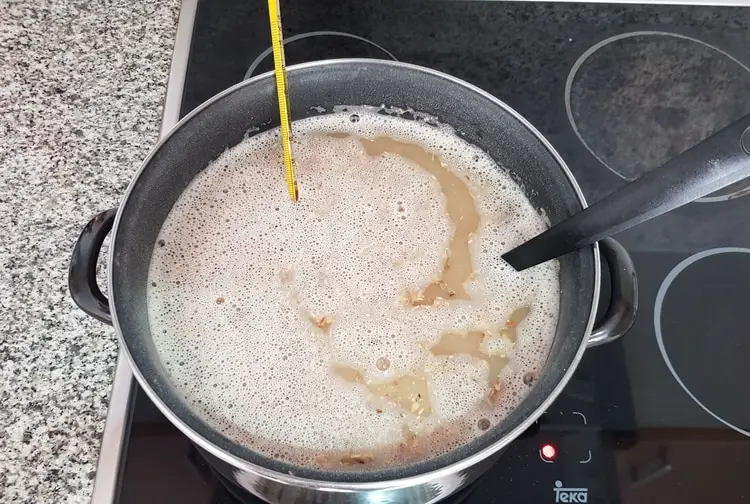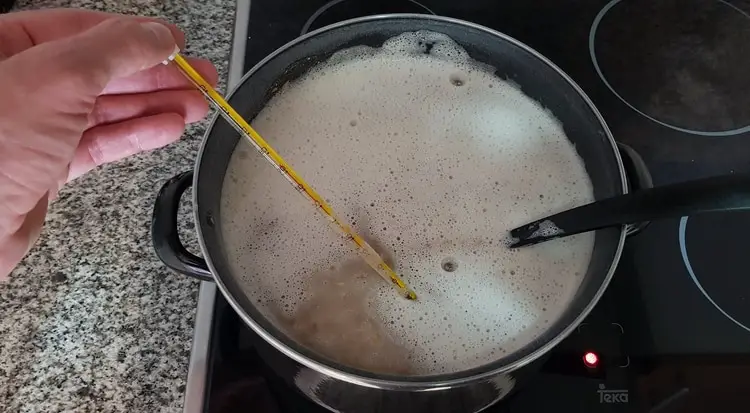When brewing homebrew beer, the mash is the part of the process where the grains in the beer are mixed with hot water and heated through, converting the grains to starch. The process of mashing begins the fermentation process that inevitably leads to an alcoholic beverage.
Beer cannot be mashed for too long, but if the wort is allowed to sit in the mash for over twenty-four hours, it may begin to sour. There is no point in leaving a beer to mash for longer than 120 minutes since most of the enzyme conversion in mashing is accomplished in the first 60 minutes of mashing. Beer mash is affected more by temperature than time.
Mashing beer is one of the most important parts of brewing and doing it incorrectly can ruin your entire batch. Keep reading to learn more about how the time and temperature of your mash can affect your beer.
What is the Purpose of the Beer Mash?
In homebrewing, the mash is the part of the homebrewing process that helps the brewer dictate the sugar profile in their beer.
This, in turn, affects both the body of the beer (how full-bodied it is) as well as the final alcohol by volume (ABV) content.
The more sugar a beer generates during fermentation, the higher its ABV will ultimately be.
What Enzymes Are Active During a Beer Mash?
During the mash, enzymes are activated by heating the grains in the water, and these enzymes convert starch to fermentable sugar, proteins are broken down, and the cell wall structures of the grain itself are broken down.
The following enzymes are activated during a beer mash according to the temperature range of the mash:
- 104-127°F (40-52°C): Cellular breakdown—Endoglucanase, beta solubilase, phosphatase
- 113-122°F (45-50°C): Protein breakdown—Endo-peptidase, carboxy-peptidase, amino-peptidase,
di-peptidase - 95-167°F (35-75°C): Starch breakdown—Beta-amylase, alpha-amylase, limitdetrinase, maltase, saccharase
As you can see, the profile of the beer mash is much more affected by the temperature of the mash than by the amount of time it is mashed.
As long as the mash isn’t allowed to spoil (which can happen quickly when grains are left in a hot mash for longer than twenty-four hours), then the beer is much more affected by how hot the mash is maintained while the process is undertaken.
Enzyme Activity Decreases with Mash Time
The main reason that it doesn’t help to mash a beer for longer than approximately two hours is that enzyme activity decreases significantly as time goes on in the mash, even if an appropriate temperature is maintained.
After all, there is only so much sugar in grains that can be converted into starch before the mash is rendered chemically inert.
Therefore, past a certain point, the only thing you’re doing by leaving your beer in the mash is increasing the chances of your mash going sour in the wort and spoiling the whole batch.
Ideally, the wort should be transferred out of the mash after two hours, and for most beers, sixty minutes is plenty of time to perform a good mash.
What Happens if You Forget Your Mash?
The good news is that if you get to your beer within twenty-four hours and remove the mash, you aren’t likely to have caused any significant damage to the flavor profile of the beer if the mash was maintained a high enough temperature.
The threat comes from a mash that is performed at temperatures that are too low. If you do a taste test and the wort tastes sweet rather than sour, you’re likely good to go.
The most significant effect that mash temperature has on the flavor of the beer is that the lower the mashing temperature is, the thinner and drier the resulting beer will be.
Beers that are mashed at a higher temperature end up with a fuller body and a thicker mouthfeel since more of the grain is broken down into the beer, giving it a bready texture.
Which Types of Beer Require a Longer Mash?
There are individual types of beer, such as imperial stouts, that require a higher mashing temperature, but they don’t necessarily require a longer mash.
The only types of beer that may require a slightly longer mash are those with very starchy adjuncts, such as barley.
Almost all grain-based beer recipes can be accomplished with a mash of sixty minutes regardless of type since most starch conversion occurs under this time limit anyway.
Some types of malt can convert in a matter of five minutes or so.
So, overnight beer mashing isn’t necessary and can hurt your wort in the long-term.
Drier beers may require a more extended period of starch conversion to maintain lower mash temperature. However, there’s still not much enzyme activity persisting beyond the first hour of fermentation.
So, there aren’t many beer types that require an excessively long mash since it doesn’t accomplish as much as adjusting the mash temperature.
Why Would You Mash Beer Longer on Purpose?
There are a few reasons why someone might mash beer longer than an hour or two.
The most obvious answer is a practical one—sometimes, it’s easier to split a beer brewing operation over two days, especially if you intend to rack the beer after mashing.
Since the mash isn’t likely to sour overnight, this can be done without threatening the integrity of the beer as long as the mash maintains an even temperature.
Mashing beer too long doesn’t usually affect the taste of the beer too much as long as the mash is removed from the wort before it begins to sour, so leaving a mash to heat overnight can be done.
It’s just safer to remove the mash around 60 to 120 minutes to avoid any chance of sour mash.
What if You Mash Beer at Too High of a Temperature?

Mashing beer at too high a temperature can damage the beer’s ability to retain a head of foam and can even kill off starch conversion entirely.
Here are the results of mashing beer at too high of a temperature:
- The beer will have a sugary flavor since less of the starch fermenting in the mash can successfully convert to alcohol.
- The beer will be full-bodied since the higher temperatures lead to more protein and cellular breakdown during the fermentation process.
The key to getting a good beer mash is to maintain the temperature consistently below 167°F (75°C), and preferably a bit lower than that (less than 153°F / 67°C).
At higher temperatures than 167°F (75°C), you’ll start running into trouble.
The reason that beer mash isn’t as effective at higher temperatures is that mash at this temperature yields sugars that are too complicated for the brewing yeast to process efficiently. Simple sugars result in a much higher turnover of sugar to alcohol.
Beers that are mashed at too high of a temperature are bound to turn out both full-bodied and sweet.
In some beers, this kind of presentation might be suitable, but in most, it’s not the favored outcome of the brew.
Mashing Beer is an Art Form
It often takes homebrewing amateurs several attempts to get a feel for how long a mash should be performed.
When in doubt, testing a portion of the mash with iodine to see if it turns dark (an indication of starch conversion) is a way to observe whether the mash has done its job or not.
The most important thing to remember when mashing beer is that the temperature of the mash dictates the outcome of the wort, and a variation of just 5 to 10°F (2-4°C) can make a big difference in the resulting taste of your brew.
Monitoring both the temperature and the time of your beer mash is crucial for consistent, successful results.
